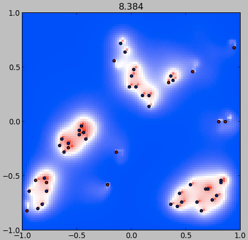
We have developed a simulation platform for Micreagents that captures electronic-chemical processes and interactions of lablets, the docking station and chemistry on the system level. The approach empowers us to study emergent ChemBio-ICT capabilities that result from the two-way communication process between the chemical and electronic components through sensor-actuator loops.
The simulation platform consists of a partial differential equation solver (representing a top view on the docking station) in which concentration fields of arbitrarily many chemicals can be tracked. Partial differential equations are used to describe chemical diffusion as well as decay. Embedded into this chemical space is a set of point particles that represent lablets equipped with the capabilities to perform random walks, electro-osmotic gradient ascent, local sensing of chemical concentrations, manipulation of chemical fields through reactions, and eventually the programmatic variation of any of the above through an internal state machine. In the first project period, we have used our simulation framework to study exemplary, elemental BioChem-ICT functionalities that underlie chemical swarm robotics (flocking), programmed pattern formation (line generation), and chemical manufacturing (directed material transport).
Equipped with this framework, we are developing high-level programming languages in the line of amorphoous computing languages in order to control the complex interplay of electronic and chemical signalling in collective lablet systems.
